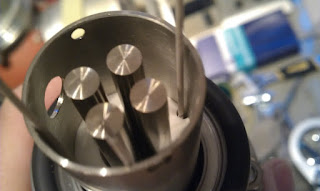So, how would it be possible to make a virtual cathode with the spherical octahedron configuration?
What we need is a volume where the magnetic field strength is low or zero, confined within a stronger magnetic field.
Take a look at the following picture:
Still the same core, but now it's surrounded by 8 coils, this picture also shows the 8 electron guns.
The core is at a high positive electric potential (e.g. +50kV), the outer coils (pinch-coils) are at a medium positive potential (e.g. +500...1000V) and the wehnelt cylinders are at a low positive potential (e.g. +50V), the hot cathodes of the electron guns are slightly more positive (e.g. +55V) than the wehnelt cylinders. (to prevent electrons flowing from the electron gun cathodes to the grounded reactor wall the electron gun cathodes are not at ground potential.)
The current through the outer coils creates a magnetic field in the opposite direction of the magnetic field created by the sphere triangle it is facing, cancelling the magnetic field in the center of the sphere triangle.
They will "pinch holes" in the magnetic field of the core, that's why I call them pinch-coils. (originally I thought these coils would have to have their magnetic field in the opposite direction, making the field lines outside the core straight in stead of diverging, creating a strong focus effect for the electron beam, it might still be interesting to do that experiment also, in that case I would call them focus-coils).
The volume where the magnetic field is low or zero takes the shape of a "stretched cube with long points", as if you would take a cube and pull the corners until they are long enough to just touch the centre of the outer coils.
This is exactly the shape needed to confine the electrons in the centre and be able to inject the electron beams.
Just as in the polywell, this could create a cloud of electrons in the centre of the core.
But that still means that electrons loose energy and slow down, the fastest electrons passing through the centre of the core and the slower electrons drifting towards the grid and hitting the grid.
As in the polywell this process will "blur" the virtual cathode.
When the electrons are leaving the core, they slow down, turn around, get accelerated in the opposite direction and enter the core again. In this process they loose energy (brehmsstralung again), so they will slow down and blur the virtual cathode.
This can be prevented by superimposing an AC voltage on the pinch coil potential. This AC voltage should have the same period as the time it takes for an electron to travel from one pinch coil through the core to the pinch coil on the other side of the core.
The idea is to create an oscillating virtual cathode (in resonance), where the electrons don't slow down, in other words, the losses are compensated by the AC power applied to the pinch coil potential. (The load on the AC power supply behaves as a capacitor with a high dielectric loss, the "dielectric loss" is the power needed to prevent the electrons from slowing down).
Not only the brehmstrahlung losses have to be compensated, when we have an oscillating virtual cathode the electrons form "bunches", just like they do in a klystron, these bunches induce currents in the core, this energy is also lost and can be compensated by the AC power on the pinch coils.
This is completely different compared to the polywell, in the polywell the electrons have a wide energy distribution and the virtual cathode is a statistical effect, a cloud of electrons, in the resonating octavio the electrons have a narrow energy distribution and the virtual cathode is oscillating and sharp.
Next step would be to see if it's possible to apply POPS, maybe by superimposing an extra AC voltage of a lower frequency on the potential of the pinch coils, maybe it's enough if the the octavio resonance frequency is a multiple of the POPS frequency.
This sounds great, if it was true.....
However, if an electron would be kept on it's track by the "magnetic tunnel" created by the octavio core and the pinch coils, then it's path would be bent in the wrong way when the electron travels the other way.
So we have to use focus coils, not pinch coils, where the electron path outside the core will be a spiral.
I will explane more about the focus-coil configuration in octavio "part three", in part one I explaned that the core alone would not work, the core with focus coils might create a virtual cathode, probably a spherical "shell like" virtual cathode.
The experiment will be about the core with focus coils and an AC voltage on the focus coils to compensate bremsstrahlung, synchrotron radiation and bunch-induction losses.






















































